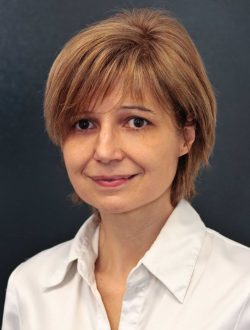Biography
Almudena Suárez received her Ph.D. in Physical Sciences from the Universidad de Cantabria in 1992, and her Ph.D. in Electronics from the University of Limoges, France, in 1993. She is currently a full professor at University of Cantabria (Spain) and head of the research group Microwave Engineering and Radiocommunication Systems. She is a Fellow member of the IEEE (“For applications of stability analysis to the computer aided design of microwave circuits”) since 2012. She was an IEEE Distinguished Microwave Lecturer from 2006 to 2008. She has published 115 papers in IEEE journals, with 79 papers in IEEE Transactions on Microwave Theory and Techniques (IEEE T-MTT). She has authored the book “Analysis and Design of Autonomous Microwave Circuits” (IEEE-Wiley, 2009) and co-authored the book “Stability Analysis of Nonlinear Microwave Circuits” (Artech House, 2003). She has been a member of the TPRCs of IEEE International Microwave Symposium (IMS) since 2004 and European Microwave Week (EuMW) since 2014. She was a member of the Board of Directors of European Microwave Association (EuMA) from 2012 to 2020. She was the Publication Officer of EuMA from 2021 to 2023. She received the Research Award of the Social Council of the University of Cantabria in 2021. She was the coordinator of the Communications and Electronic Technology Area for the Spanish National Evaluation and Foresight Agency (ANEP) from 2009 to 2013. She was the chair of the 2014 and 2015 editions of IEEE Topical Conference on RF/Microwave Power Amplifiers (PAWR), in Newport Beach and San Diego. She was the General TPC Chair of EuMW 2018. Prof. Suárez was the Editor-in-Chief of the International Journal of Microwave and Wireless Technologies from Cambridge University Press journals (IJMWT) from 2013 to 2018. She has been an Associate Editor for IEEE Microwave Magazine since 2014 and was an Associate Editor for IEEE T-MTT in 2019-2022. She was been the Chair of the IEEE Subcommittee for the Best paper Award in IEEE Microwave Magazine from 2017 to 2021. Since 2023 she is the Editor-in-Chief of IEEE T-MTT.
Presentations
Global Stability Analysis and Stabilization of Power Amplifiers
Power amplifiers often exhibit instabilities giving rise to frequency division by two or oscillations at incommensurate frequencies. These phenomena, observed from a certain level of input power, cannot be detected through a small-signal stability analysis of the circuit. Instead, a large-signal stability analysis must be performed. Other behaviors, like hysteresis and chaotic solutions, can also be obtained when the input power is varied. The qualitative changes in the output-power spectrum are due to bifurcations or qualitative stability changes in the circuit solution or in the number of solutions when the parameter is varied. The talk introduces the local and global stability concepts and the analysis techniques, based on harmonic balance. The first objective is to allow a good comprehension of the different phenomena. The second objective is to provide practical simulation tools for an efficient prediction and elimination of the undesired behavior. Different approaches for the local-stability analysis of nonlinear regimes will be presented, with emphasis on the pole-zero identification. Then, techniques will be shown for the detection of the most common types of bifurcations in power amplifiers. The final goal will be the stabilization of the circuit and the design corrections in order to suppress the undesired phenomena will also be presented.
For illustration, the simulation tools will be applied to two different switching amplifiers developed at California Institute of Technology. These amplifiers have remarkably high efficiency, but in intermediate input-power range they exhibited different undesired phenomena. The first amplifier is a Class-E/F amplifier, which showed oscillations, hysteresis and chaos. The second amplifier is a Class-E amplifier, which showed jumps in the power-transfer curve and sideband noise amplification. After the application of the different techniques, the two amplifiers were globally stabilized for all the expected operating values of the amplifier bias voltage and input power. This was achieved with negligible degradation of the amplifier performance, in terms of output power and drain efficiency. The stable behaviour obtained in simulation was experimentally confirmed.
